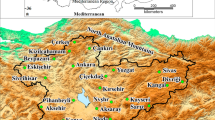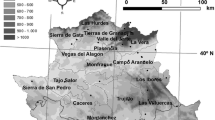Abstract
This study aimed to identify the most suitable growing periods for greenhouse production in Turkey in order to make valuable contribution to economic viability. Data collected from the meteorological databases of 81 provinces was used to determine periodic climatological requirements of greenhouses in terms of cooling, heating, natural ventilation, and lighting. Spatial distributions of mean daily outside temperatures and greenhouse heating requirements were derived using ordinary co-kriging (OCK) supported by Geographical Information System (GIS). Mean monthly temperatures throughout the country were found to decrease below 12 °C in January, February, March, and December, indicating heating requirements, whereas temperatures in 94.46 % of the country rose above 22 °C in July, indicating cooling requirements. Artificial lighting is not a requirement in Turkey except for November, December, and January. The Mediterranean, Aegean, Marmara, and Black Sea Regions are more advantageous than the Central, East, and Southeast Anatolia Regions in terms of greenhouse production because the Mediterranean and Aegean Regions are more advantageous in terms of heating, and the Black Sea Region is more advantageous in terms of cooling. Results of our study indicated that greenhouse cultivation of winter vegetables is possible in certain areas in the north of the country. Moreover, greenhouses could alternatively be used for drying fruits and vegetables during the summer period which requires uneconomical cooling systems due to high temperatures in the Mediterranean and Southeastern Anatolian Regions.





Similar content being viewed by others
References
Alsamamra H, Ruiz-Arias JA, Pozo-Va’zquez D, Tovar-Pescador J (2009) A comparative study of ordinary and residual kriging techniques for mapping global solar radiation over southern Spain. Agr Forest Meteorol 149(8):1343–1357
ASHRAE (2005) Fundamentals SI. Environmental control for animals and plants—physiological considerations. ASHRAE, Atlanta, GA
Bailey TC, Gatrell AC (1995) Interactive spatial data analysis. Longman Higher Education, Harlow
Baudoin W, Grafiadellis M, Jiminez R, La Malfa G, Martinez-Garcia PF, Garnaud JC, Montero AA, Nisen A, Verlodt H, de Villele O, von Zabeltitz C (1991) Protected cultivation in the Mediterranean climate. FAO plant production and protection paper no. 90
Baytorun N, Abak K, Üstün S, İkiz Ö (1996) GAP alanında sera tarımı potansiyeli sahil bölgeleri ile karşılaştırılması. GAP 1.Sebze Tarımısempozyumu Şanlıurfa
Cemek B (2005) Samsun İl ve ilçelerinde seraların iklimsel ihtiyaçlarının belirlenmesi. OMÜ. Zir Fak 20(3):34–43
Chuanyan Z, Zhongren N, Guodong C (2005) Methods for modelling of temporal and spatial distribution of air temperature at landscape scale in the southern Qilian mountains. China Ecol Model 189:209–220
Coops N, Loughhead A, Ryan P, Hutton R (2001) Development of daily spatial heat unit mapping from monthly climatic surfaces for the Australian continent. Int J Geogr Inf Sci 15:345–361
Daly C, Neilson RP, Phillips D (1994) A statistical-topographical model for mapping climatological precipitation over mountainous terrain. J Appl Meteorol 33(2):140–158
Diodato N, Ceccarelli M (2005) Interpolation processes using multivariate geostatistics for mapping of climatological precipitation mean in the Sannio mountains (southern Italy). Earth Surf Proc Land 30(3):259–268
Gomez KA, Gomez AA (1984) Statistical procedures for agricultural research, 2nd edn. John Wiley and Sons, Singapore
Goovaerts P (1997) Geostatistics for natural resources evaluation. Oxford University Press, New York
Goovaerts P (1999) Using elevation to aid the geostatistical mapping of rainfall erosivity. Catena 34:227–242
Goovaerts P (2000) Geostatistical approaches for incorporating elevation into the spatial interpolation of rainfall. J Hydrol 228:113–129
Güler M, Cemek B, Günal H (2007) Assessment of some spatial climatic layers through GIS and statistical analysis techniques in Samsun Turkey. Meteorol Appl 14(2):163–169
Kendirli B, Çakmak B, Gökalp Z (2007) Analysis of climate factors for the development of greenhouses in eastern Black Sea region. Build Environ 42(7):4072–4078
Krug H, Liebig HP, Stutzel H (2002) Gemüseproduktion. Ulmer Verlag, Stuttgart
Li J, Andrew DH (2011) A review of comparative studies of spatial interpolation methods in environmental sciences: performance and impact factors. Ecol Inform 6:228–241
MGM (2010) Meteorology bulletin reports, Turkey
Moral FJ (2010) Comparison of different geostatistical approaches to map climate variables: application to precipitation. Int J Climatol 30:620–631
Nalder IA, Wein RW (1998) Spatial interpolation of climatic normals: test of a new method in the Canadian boreal forest. Agric For Meteorol 92:211–225
Phillips DL, Dolph J, Marks D (1992) A comparison of geostatistical procedures for spatial analysis of precipitation in mountainous terrain. Agric For Meteorol 58:119–141
Spadavecchia L, Williams M (2009) Can spatio-temporal geostatistical methods improve high resolution regionalisation of meteorological variables? Agric For Meteorol 149(6–7):1105–1117
Stefanescu V, Stefan S, Georgescu F (2013) Spatial distribution of heavy precipitation events in Romania between 1980 and 2009. Meteorol Appl. doi:10.1002/met.1391
Toy S, Yilmaz S, Yilmaz H (2007) Determination of bioclimatic comfort in three different land uses in the city of Erzurum, Turkey. Build Environ 42:1315–1518
TUIK (2012) Available at http://www.tuik.gov.tr. 2012. (accessed 01.02.2014)
Tuzel Y, Gul A, Dasgan HY, Oztekin GB, Engindeniz S, Boyacı HF, Ersoy A, Tepe A, Ugur A (2010) Örtüaltı Yetiştiriciliğinin gelişimi. TMMOB Ziraat Mühendisleri Odası Türkiye Ziraat Mühendisliği VII. TeknikKongresi Bildiriler Kitabı: 559–576,11–15, Ankara
von Elsner B, Briassoulis D, Waaijenberg D, Mistriotis A, von ZabeltitzChr GJ, Russo G, Suay-Cortes R (2000) Review of structural and functional characteristics of greenhouses in European Union countries, part I: design requirements. J Agr Eng Res 75(1):1–16
Von Zabeltitz C (1999) Greenhouse structures. In: Stanhill G, Zvi Enoch H (eds) Greenhouse ecosystems, Ecosystems of the world, vol 20. Elsevier, Amsterdam, pp. 17–69
Von Zabeltitz C (2011) Integrated greenhouse systems for mild winter climates: climatic conditions, design, construction, maintenance and climate control. Springer-Verlag, Berlin
Von Zabeltitz C, Baudoin W (1999) Greenhouses and shelter structures for tropical regions. FAO plant production and protection paper no. 154
Wan KKW, Danny HWL, Wenyan P, Joseph CL (2012) Impact of climate change on building energy use in different climate zones and mitigation and adaptation implications. Appl Energ 97:274–282
Yıldırım D, Meral R (2010) Güneydoğu anadolu projesi (GAP) bölgesi ve civari illerde seraların iklimlendirme gereksinimleri. Harran Zir Fak 14(4):13–22
Yurekli K, Simsek H, Cemek B, Karaman S (2007) Simulating climatic variables by using stochastic approach. Build Environ 42:3493–3499
Author information
Authors and Affiliations
Corresponding author
Rights and permissions
About this article
Cite this article
Cemek, B., Güler, M. & Arslan, H. Spatial analysis of climate factors used to determine suitability of greenhouse production in Turkey. Theor Appl Climatol 128, 1–11 (2017). https://doi.org/10.1007/s00704-015-1686-5
Received:
Accepted:
Published:
Issue Date:
DOI: https://doi.org/10.1007/s00704-015-1686-5




